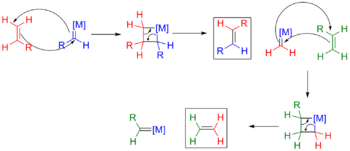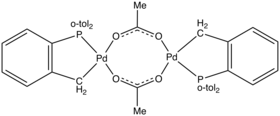Metallacycle
In organometallic chemistry, a metallacycle is a derivative of a carbocyclic compound wherein a metal has replaced at least one carbon center;[2][3] this is to some extent similar to heterocycles. Metallacycles appear frequently as reactive intermediates in catalysis, e.g. olefin metathesis and alkyne trimerization. In organic synthesis, directed ortho metalation is widely used for the functionalization of arene rings via C-H activation. One main effect that metallic atom substitution on a cyclic carbon compound is distorting the geometry due to the large size of typical metals.
Nomenclature
Typically, metallacycles are cyclic compounds with two metal carbon bonds.[4]

Many compounds containing metals in rings are known, for example chelate rings. Usually, such compounds are not classified as metallacycles, but the naming conventions are not rigidly followed. Within the area of coordination chemistry and supramolecular chemistry, examples include metallacrowns, metallacryptands, metallahelices, and molecular wheels.
Classes of metallacycles
Metal-alkene complexes can be viewed as the smallest metallacycles, but they usually are not classified as metallacycles. In the Dewar–Chatt–Duncanson model, one resonance structure for the M(η2-alkene) center is the metallacyclopropane.

Metallacyclobutanes
The parent metallacyclobutane has the formula LnM(CH2)3 where L is a ligand attached to M. A stable example is (PPh3)2Pt(CH2)3. The first example was prepared by oxidative addition of cyclopropane to platinum.

Metallacyclobutane intermediates are involved in the alkene metathesis and in the oligomerization and dimerization of ethylene. In alkene metathesis, the Chauvin mechanism invokes the attack of an alkene at an electrophilic metal carbene catalyst.[5][6][7] This work helped to validate the Chauvin mechanism for olefin metathesis.
Metallacyclopentadienes and metallabenzenes
The parent metallacyclopentadiene has the formula LnM(CH)4. Most arise from the coupling of two alkynes at a low valent metal centers such as derivatives of Co(I) and Zr(II). Late metal derivatives (Co, Ni) are intermediates in the metal-catalysed trimerization of alkynes to arenes. Early metal derivatives, i.e. derivatives of Ti and Zr, are used stoichiometrically.[4] For example, the zirconacyclopentadiene Cp2ZrC4Me4 is a useful carrier for C4Me42−.[8] Some of the oldest metallacycles are the ferroles, which are dimetallacyclopentadiene complexes of the formula Fe2(C2R4)(CO)6. They are derived from coupling of alkynes as well as from the desulfurization of thiophenes.[9]
The parent metallacyclobenzenes have the formula LnM(CH)5. They can be viewed as derivatives of benzene wherein a CH center has been replaced by a transition metal complex.[10]
Metallacyclopentanes
The parent metallacyclopentane has the formula LnM(CH2)4. Such compounds are intermediates in the metal catalysed dimerization, trimerization, and tetramerization of ethylene to give 1-butene, 1-hexene, and 1-octene, respectively.[11] Metallacyclopentanes are invoked as intermediates in the evolution of heterogeneous alkene metathesis catalysts from ethylene and metal oxides. Metallacyclopentane intermediates are proposed to isomerize to metallacyclobutanes, which then eliminate propylene giving the alkylidene.[12]
Ortho-metalation

Metallacycles often arise by cyclization of arene-containing donor ligands, e.g. aryl phosphines and amines. An early example is the cyclization of IrCl(PPh3)3 to give the corresponding Ir(III) hydride containing a four-membered IrPCC ring.[14] Palladium(II) and platinum(II) have long been known to ortho-metalate aromatic ligands such as azobenzene, benzylamines, and 2-phenylpyridines.[15] These reactions are strongly influenced by substituent effects, including the Thorpe-Ingold Effect.[16] Ligands that lack aryl substituents will sometimes cyclometalate via activation of methyl groups, an early example being the internal oxidative addition of methylphosphine ligands.[17] Metallacycle formation interferes with intermolecular C-H activation processes. For this reason, specialized "pincer ligands" ligands have been developed that resist ortho-metalation.
References
- R. J. Klingler; J. C. Huffman; J. K. Kochi (1982). "Synthesis, structure, and electrochemistry of platinum(II) metallacyclobutanes". J. Am. Chem. Soc. 104 (8): 2147–2157. doi:10.1021/ja00372a010.
- Elschenbroich, C. ”Organometallics” (2006) Wiley-VCH: Weinheim. ISBN 978-3-527-29390-2
- Jolly, William L. (1989). Modern Inorganic Chemistry (third ed.). McCraw-Hill. ISBN 0-07-032760-2.
- Rosenthal, Uwe; Burlakov, Vladimir V.; Bach, Marc A.; Beweries, Torsten (2007). "Five-membered metallacycles of titanium and zirconium – attractive compounds for organometallic chemistry and catalysis". Chem. Soc. Rev. 36 (5): 719–728. doi:10.1039/b605734a.
- "Press Release: The Nobel Prize in Chemistry 2005". Retrieved 3 December 2009.
- Hérisson, J.-L.; Chauvin, Y. (1971). "Catalyse de transformation des oléfines par les complexes du tungstène. II. Télomérisation des oléfines cycliques en présence d'oléfines acycliques". Makromol. Chem. 141: 161–176. doi:10.1002/macp.1971.021410112.
- Schrock, R.R. (1986). "On the trail of metathesis catalysts". J. Organomet. Chem. 300 (1–2): 249–262. doi:10.1016/0022-328X(86)84064-5.
- Paul J. Fagan, William A. Nugent (1998). "1-Phenyl-2,3,4,5-Tetramethylphosphole". Organic Syntheses.; Collective Volume, 9, p. 653
- G. Dettlaf, E. Weiss "Kristallstruktur, 1H-NMR- und Massenspektrum von Tricarbonylferracyclopentadien-Tricarbonyleisen, C4H4Fe2(CO)6 Journal of Organometallic Chemistry 1976, vol. 108, pp. 213-223.
- Bleeke, J.R. (2001). "Metallabenzenes". Chem. Rev. 101 (5): 1205–27. doi:10.1021/cr990337n. PMID 11710218.
- Dixon, John T.; Green, Mike J.; Hess, Fiona M.; Morgan, David H. (2004). "Advances in selective ethylene trimerisation – a critical overview". Journal of Organometallic Chemistry. 689 (23): 3641–3668. doi:10.1016/j.jorganchem.2004.06.008.
- Schrock, R. R.; Coperet, C. (2017). "Formation of High-Oxidation-State Metal-Carbon Double Bonds". Organometallics. 36: 1884–1892. doi:10.1021/acs.organomet.6b00825. hdl:1721.1/115114.CS1 maint: uses authors parameter (link)
- Herrmann, W. A.; Brossmer, C.; Reisinger, C.-P.; Riermeier, T. H.; Öfele, K.; Beller, M. (1997). "Palladacycles: Efficient New Catalysts for the Heck Vinylation of Aryl Halides". Chemistry – A European Journal. 3 (8): 1357–1364. doi:10.1002/chem.19970030823.CS1 maint: uses authors parameter (link)
- Bennett, M. A.; Milner, D. L. (1969). "Chlorotris(triphenylphosphine)iridium(I) and related complexes. Oxidative addition reactions and hydrogen abstraction from the coordinated ligand". J. Am. Chem. Soc. 91 (25): 6983–6994. doi:10.1021/ja01053a016.
- Cope, A. C.; Siekman, R. W. (1965). "Formation of Covalent Bonds from Platinum or Palladium to Carbon by Direct Substitution". J. Am. Chem. Soc. 87 (14): 3272–3273. doi:10.1021/ja01092a063.
- Shaw, B. L. (1975). "Formation of large rings, internal metalation reactions, and internal entropy effects". J. Am. Chem. Soc. 97 (13): 3856–3857. doi:10.1021/ja00846a072.
- Chatt, J.; Davidson, J. M. (1965). "The tautomerism of arene and ditertiary phosphine complexes of ruthenium(0), and the preparation of new types of hydrido-complexes of ruthenium(II)". J. Chem. Soc.: 843. doi:10.1039/JR9650000843.
.png)